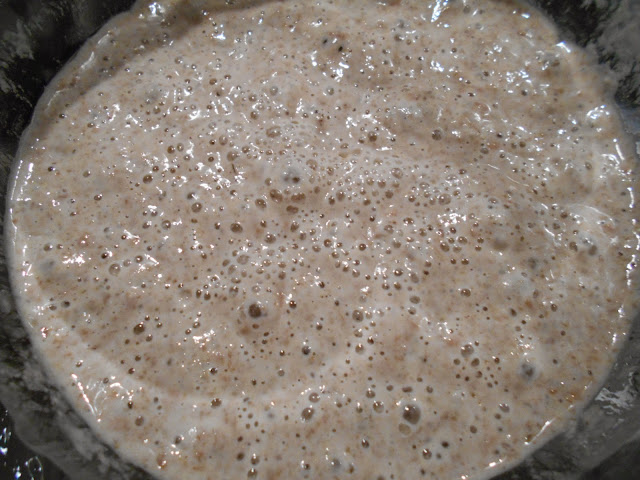This page is dedicated to sourdough baking. Our favourite way of baking!
To start sourdough baking you need a sourdough starter....
What's a sourdough starter?
"Sourdough starter is a stable symbiotic culture of wild yeasts and bacteria. The yeasts break down starches into sugars, which the bacteria eat. The bacteria, on the other hand, create an acidic environment that kills off competitors to the yeasts. The yeasts were almost certainly already living on the grains when they were out in the field. As for the bacteria, that’s a trickier question, but the consensus seems to be that they come from us – studies have failed to isolate Lactobacillus Sanfranciscensis anywhere except in long-lived sourdough starters and on human teeth. The individual mix of yeasts and bacteria varies from starter to starter, and region to region. It’s part of their charm; every starter is unique, and produces bread that tastes somewhat different from those produced with other starters" Sourdough starters work more slowly than commercial yeasts, which are much more concentrated. A sourdough loaf will rise for at least three to four hours in the bowl and will then need another two to three hours as a shaped loaf before it will be ready to bake. Different starters will produce different levels of sourness, but by far the most important factor in a sourdough bread’s flavor is temperature. If the dough is allowed to ferment at 80 to 85 degrees or is allowed to rise slowly overnight in the fridge or in a cool room (35 to 50 degrees F), the bread will have a markedly stronger flavor than a sourdough that rose at room temperature (65 – 70 degrees F). Sourdough breads generally keep well, because their acid content slows down the staling process. In addition, the acid in sourdough both reduces the impact of bread on one’s blood sugar and also neutralizes phytic acid in whole wheat breads. Phytic acid prevents the body from absorbing many nutrients. (from : "The fresh loaf handbook, www.thefreshloaf.com")
Starting a starter : click on the link below to start the adventure...
how to start a sourdough starter
To start sourdough baking you need a sourdough starter....
What's a sourdough starter?
"Sourdough starter is a stable symbiotic culture of wild yeasts and bacteria. The yeasts break down starches into sugars, which the bacteria eat. The bacteria, on the other hand, create an acidic environment that kills off competitors to the yeasts. The yeasts were almost certainly already living on the grains when they were out in the field. As for the bacteria, that’s a trickier question, but the consensus seems to be that they come from us – studies have failed to isolate Lactobacillus Sanfranciscensis anywhere except in long-lived sourdough starters and on human teeth. The individual mix of yeasts and bacteria varies from starter to starter, and region to region. It’s part of their charm; every starter is unique, and produces bread that tastes somewhat different from those produced with other starters" Sourdough starters work more slowly than commercial yeasts, which are much more concentrated. A sourdough loaf will rise for at least three to four hours in the bowl and will then need another two to three hours as a shaped loaf before it will be ready to bake. Different starters will produce different levels of sourness, but by far the most important factor in a sourdough bread’s flavor is temperature. If the dough is allowed to ferment at 80 to 85 degrees or is allowed to rise slowly overnight in the fridge or in a cool room (35 to 50 degrees F), the bread will have a markedly stronger flavor than a sourdough that rose at room temperature (65 – 70 degrees F). Sourdough breads generally keep well, because their acid content slows down the staling process. In addition, the acid in sourdough both reduces the impact of bread on one’s blood sugar and also neutralizes phytic acid in whole wheat breads. Phytic acid prevents the body from absorbing many nutrients. (from : "The fresh loaf handbook, www.thefreshloaf.com")
Starting a starter : click on the link below to start the adventure...
how to start a sourdough starter



Comments
Post a Comment